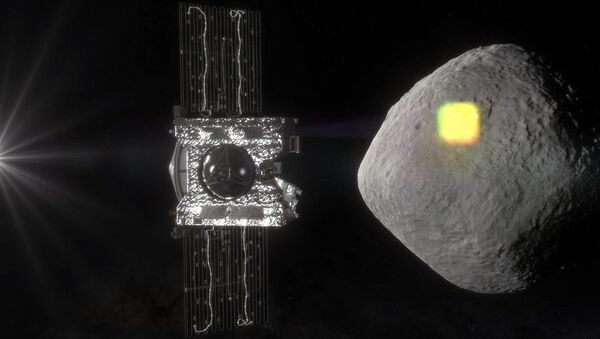The spacecraft in question is the OSIRIS-REx probe, which was launched into the cosmos in September 2016 and placed on a trajectory that allowed the craft to reach near-Earth asteroid Bennu in 2018.
Although the van-sized probe has provided the US space agency with data on the floating rock since reaching its orbit, OSIRIS-REx is now preparing to briefly touch down on Bennu in a bid to collect both rock and dust samples. The momentary landing is expected to take place on October 20.
NASA noted in a Thursday news release that the Touch-And-Go (TAG) sampling event would see the probe land on the Nightingale site, a rocky area in the asteroid’s northern hemisphere that measures 52 feet in diameter.
“Site Nightingale was selected as the mission’s primary sample site because it holds the greatest amount of unobstructed fine-grained material, but the region is surrounded by building-sized boulders,” reads the NASA release, noting that the probe will be landing in an area roughly the size of just a few parking spaces.
In total, the sample collection is expected to last about 4.5 hours; however, the majority of the time - 4 hours - will see the probe undergo the first stages of its downward trajectory, before descending at a steeper angle for some 11 minutes and then firing thrusters to slow its descent. Once OSIRIS-REx touches down on Bennu’s surface, it will only spend a total of 16 seconds on the rock before firing up its thrusters to place it a safe distance away from Bennu.
The release indicates that OSIRIS-REx will be able to collect the samples by firing off one of the probe’s pressurized nitrogen bottles, which will allow the emitted gas to lift the desired particles from Bennu’s surface into the probe’s “collector head” before liftoff.
In all, the probe is intended to collect at least 2 ounces of materials, the largest sample of any mission since the Apollo program, according to NASA.
In the four days after the trip to Bennu’s surface, one of the camera’s installed on OSIRIS-REx will snap pictures of the samples, and the craft will also conduct a spin maneuver to determine the collection’s mass. Should the samples not meet NASA’s requirements, OSIRIS-REx will be ordered to collect more material from the asteroid.
NASA stated in its release the probe is fitted with two additional nitrogen bottles in the event that additional samplings need to be carried out. “A TAG attempt at the back-up Osprey site would be made no earlier than January 2021,” the agency wrote.
It’s worth noting that the Bennu collection will be done entirely autonomously, since the approximately 207 million miles between the probe and Earth create a signal delay of 18.5 minutes, preventing a live command by NASA officials.
OSIRIX-REx is scheduled to part ways with Bennu in 2021. The probe’s return to Earth with the rock and dust samples is expected to take place on September 24, 2023, should all things go according to plan.



